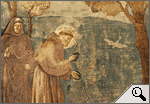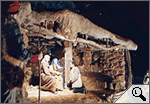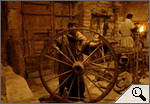|
|
|
 |
 |
 > An idea from St Francis of Assisi > In the Catalan Countries > Along streets, in squares and natural spaces dimarts, 22 de desembre de 2009
Nativities are a deep-rooted Christmas tradition in the Catalan Countries and in Southern Europe, where they have been popular since the 17th and 18th centuries.
Nativities are representations of the birth of Jesus, with figures traditionally made out of wood and clay that appear in a scene made out of moss and cork. The figures include the baby Jesus, Mary the Mother of God, St Joseph, the three Kings from the East, the angel announcing the birth of Jesus, the shepherds and animals (an ox and a mule). In our country, other figures are also popular, such as the washerwoman and, most importantly, the 'caganer' (depicting a figure defecating), often in the corner. Nativities can be found at Christmas in people's homes, in churches and in public spaces. The tradition has been around for a number of years, along with the Christmas tree, a tradition that originated in Germany. Increasingly popular, however, are live nativities with actors. In the Catalan Countries, living nativity scenes have been around for over half a century. An idea from St Francis of AssisiThe idea for the first live nativity has been attributed to St Francis of Assisi (1182-1226). The scene, with men and animals, is thought to have taken place on Christmas night in 1223 in a cave near the town of Greccio in Italy. Several years earlier, in 1208, St Francis of Assisi, who was born in the town, founded the mendicant order of Franciscan monks, which spread quickly. Its members opted to live a life of poverty.
In the Catalan CountriesIn the Catalan Countries, the first live nativity took place in 1956 in Engordany, Andorra. In Catalonia, one of the oldest and best known is that of Corbera de Llobregat (Baix Llobregat), which has taken place every year since 1962. The figures are dressed in period costumes and the scene, in excess of 700 metres, is accompanied by music, carols and stories. The tradition has become firmly established, especially in Catalonia. The Coordinating Association of Live Nativities of Catalonia lists more than 25 live nativities.
Along streets, in squares and natural spacesThe main scene for live nativities is the birth of Jesus, but some depict other Biblical scenes and old trades (carter, spinner, soap maker, etc.). Some live nativities are set in natural locations, whilst others take place in mediaeval-like narrow streets and small squares in the old quarter of a town or city. Live nativities are usually set up in the evening, as well as on the following days: Christmas Day, St Stephen's Day, New Year's Eve and the Epiphany (6 January).
|
Investiga

> Castell d'Aro: un pessebre vivent de llarga tradició.

> Que el coneixes, l'origen del pessebre? (interactiu).


> Els pastorets, tradició nadalenca molt nostrada.
I també...
- Les Gunyoles d'Avinyonet: un pessebre vivent i parlat.
- El pessebre vivent d'Osona, a Tona.
- Preguntes freqüents sobre el pessebre de Corbera de Llobregat.
- Figures de mida real al pessebre de Canillo, 'cim' d'Andorra.
Portada |
Europa Press |
El Punt |
La premsa |
Especials |
Diari de l'escola |
LesFinances.info |
Editorials |
Mail obert |
Els blocs |
Lletres
Tecnologia i ciència | Solidaritat | Cap de 7mana | Campus | El 9 | Presència | Fòrums | Enquestes | Xat | Correu
Traductor | Edicions en Pdf | Wap-pda | Biblioteca | Lletra més grossa
Tecnologia i ciència | Solidaritat | Cap de 7mana | Campus | El 9 | Presència | Fòrums | Enquestes | Xat | Correu
Traductor | Edicions en Pdf | Wap-pda | Biblioteca | Lletra més grossa
| Què és VilaWeb? Publicitat Mapa web Contacte | Una web de Partal, Maresma i Associats, S.L. |




